Formed September 26, 1963 Fatalities 7,186 - 8,000 [1] | Dissipated October 12, 1963 Highest winds 233 km/h | |
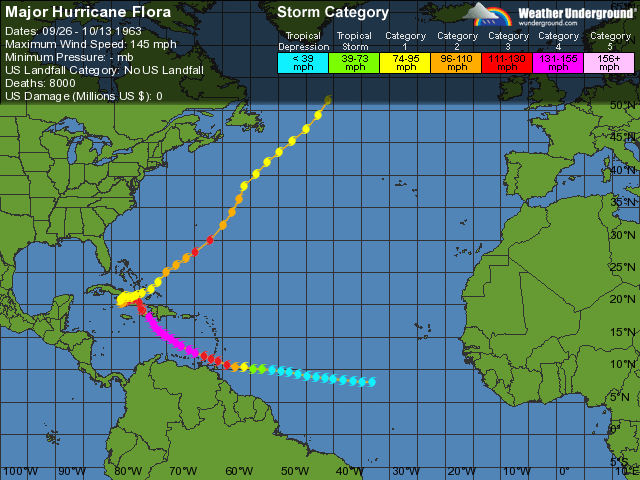 | ||
Lowest pressure 940 mbar (hPa); 27.76 inHg Damage $528 million (1963 USD) Areas affected Northern South America, Lesser Antilles, Trinidad and Tobago, Leeward Antilles, Puerto Rico, Hispaniola, Jamaica, Cuba, Bahamas, Turks and Caicos Islands, Bermuda, Atlantic Canada Date 26 September 1963 – 12 October 1963 Similar Hurricane Inez, Hurricane Cleo, Hurricane Fifi–Orlene, Hurricane Allen, Hurricane Gordon | ||
Weather history hurricane flora 1963
Hurricane Flora is among the deadliest Atlantic hurricanes in recorded history, with a death total of over 7,000. The seventh tropical storm and sixth hurricane of the 1963 Atlantic hurricane season, Flora developed from a disturbance in the Intertropical Convergence Zone on September 26 while located 755 miles (1,215 km) southwest of the Cape Verde islands. After remaining a weak depression for several days, it rapidly organized on September 29 to attain tropical storm status. Flora continued to quickly strengthen to reach Category 3 hurricane status before moving through the Windward Islands and passing over Tobago, and it reached maximum sustained winds of 145 miles per hour (233 km/h) in the Caribbean.
Contents
- Weather history hurricane flora 1963
- Hurricane flora haiti aftermath 1963
- Meteorological history
- Preparations
- Impact
- East Caribbean
- Dominican Republic and Haiti
- Cuba Jamaica the Bahamas and Florida
- Aftermath
- References
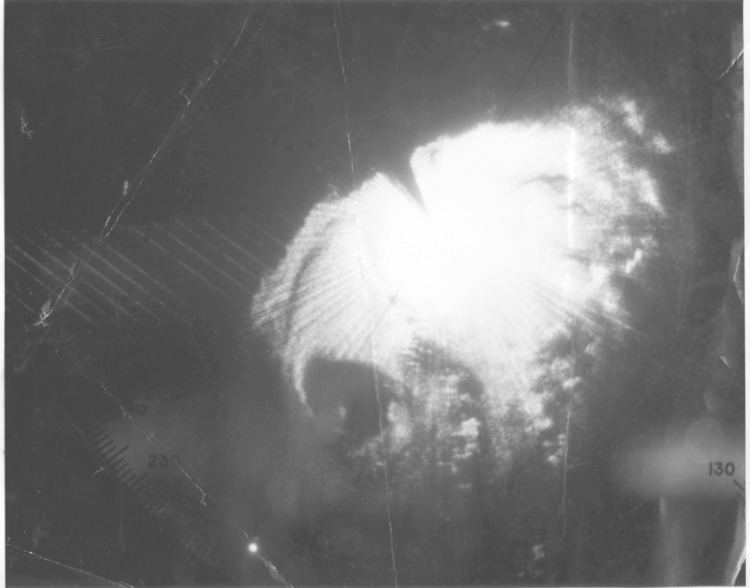
The storm struck southwestern Haiti near peak intensity, turned to the west, and drifted over Cuba for four days before turning to the northeast. Flora passed over the Bahamas and accelerated northeastward, becoming an extratropical cyclone on October 12. Due to its slow movement across Cuba, Flora is the wettest known tropical cyclone for Cuba, Haiti, and the Dominican Republic. The significant casualties caused by Flora were the most for a tropical cyclone in the Atlantic Basin since the 1900 Galveston Hurricane.
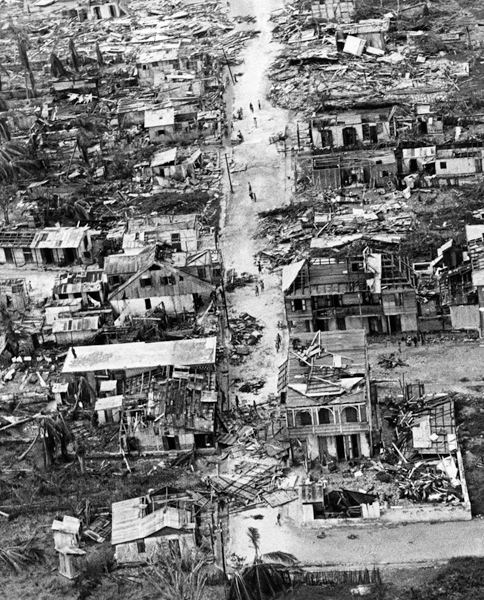
Hurricane flora haiti aftermath 1963
Meteorological history

A disturbance in the Intertropical Convergence Zone organized into a tropical depression on September 26 while located about 755 miles (1,215 km) southwest of the island of Fogo in the Cape Verde Islands. Upon forming, the depression had a poorly organized circulation with banding features to its north and east. The depression moved west-northwestward, and the system failed to organize significantly by a day after developing. On September 27, the banding features dissipated, though the area of convection around the center increased. Satellite imagery was unavailable until September 30, during which there were not sufficient ship reports to indicate the presence of a low-level circulation. The depression continued west-northwestward, and it is estimated it intensified into Tropical Storm Flora on September 29 while located about 560 miles (900 km) east-southeast of Trinidad, or about 350 miles (560 km) north of Cayenne, French Guiana. Operationally, advisories were not initiated until a day later.

Flora quickly intensified after it became a tropical storm, and early on September 30 it attained hurricane status. Later that day, Reconnaissance Aircraft confirmed the existence of the hurricane, with the flight reporting a well-defined, circular 8-mile (13 km) wide eye. One observer noted Flora to be the best organized tropical cyclone over the previous two years. After attaining major hurricane status, Flora passed directly over the island of Tobago late on the 30th with winds of 120 mph (190 km/h). The hurricane continued west-northwestward as it entered the Caribbean, and early on October 2 its winds reached 140 miles per hour (230 km/h). Thirty hours later, Flora intensified slightly further and attained peak winds of 145 mph (233 km/h) while located about 105 miles (169 km) south of the border of Haiti and the Dominican Republic.
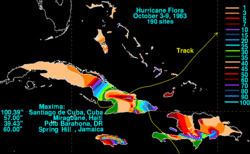
After turning to the northwest, Hurricane Flora maintained its peak strength, and made landfall in the Sud Department of Haiti late on October 3 as a 145 mph (233 km/h) Category 4 hurricane on the Saffir-Simpson Scale with gusts from 180 to 200 miles per hour (290 to 320 km/h). The calm of the eye lasted for up to 70 minutes in one location. After quickly weakening to a 120 mph (190 km/h) hurricane, Flora turned more to the west in the Windward Passage, and restrengthened slightly to strike southeastern Cuba about 30 miles (48 km) east of Guantanamo Bay with winds of 125 mph (201 km/h). A high pressure system to its north turned the motion of the hurricane to a westward drift, causing it to weaken quickly over land. Flora neared the north coast of Cuba on October 4 before turning to the south. It executed a cyclonic loop and entered the coastal waters off Granma Province. An anticyclone to the west of Flora turned the hurricane to the north, bringing it ashore near Santa Cruz del Sur on October 7 with winds of around 90 mph (140 km/h). Flora initially turned southeastward over central Cuba, and late on October 8 a short-wave trough turned the hurricane northeastward, bringing it into the coastal waters of the Holguín Province. Flora remained a hurricane while drifting over land due to abundant moisture and a favorable upper level environment.
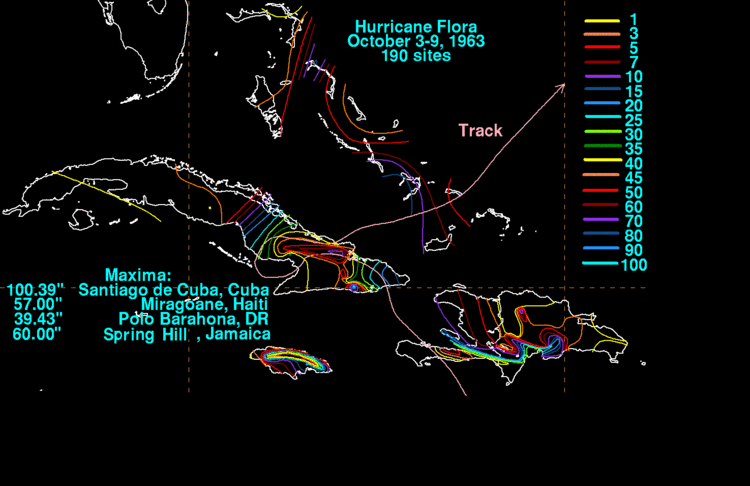
After passing over the southeastern Bahamas early on October 9, Flora began to restrengthen, and on October 10 it again reached major hurricane status while located 290 miles (470 km) south of Bermuda. The hurricane gradually weakened as it continued northeastward, and weakened to a Category 1 hurricane on October 11. Flora gradually lost its convection over the north Atlantic Ocean, and transitioned into an extratropical cyclone on October 12 while located 270 miles (430 km) east-southeast of Cape Race, Newfoundland. The extratropical remnant dissipated the next day.
Preparations
The Weather Bureau in San Juan, Puerto Rico issued a hurricane warning for Trinidad, Tobago, and the Grenadines south of Saint Vincent in the cyclone's first advisory on Hurricane Flora. Gale warnings were later issued for islands off northern Venezuela and from Saint Vincent northward to Martinique. Advisories on Flora emphasized the danger of the hurricane and advised preparations to be rushed to completion. The advisories also recommended small craft throughout the Windward Islands to remain at harbor and for shipping in the path of the hurricane to advise extreme caution. People in low-lying areas and near beaches were advised to evacuate to higher grounds, as well. Lead time was short, especially in Tobago which received news of the approaching hurricane just two hours before it struck.
On October 2, two days before it made landfall on southwestern Hispaniola, the San Juan Weather Bureau issued a gale warning from Barahona in the Dominican Republic to the Sud-Est Department of Haiti. Advisories recommended small craft in the southern portions of the countries to remain at port. Later that day, the gale warning was upgraded to a hurricane warning in southwestern Haiti. On the day of when Flora made landfall, advisories recommended all citizens on beaches and in low-lying areas west of Santo Domingo to evacuate. Carmelo Di Franco, the provisional Director of Civic Defense for the Dominican Republic, organized safety procedures and the dissemination of tropical cyclone bulletins from the San Juan Weather Bureau. Di Franco also organized for the transmission of hurricane emergency information to citizens, believed to reduce the loss of life. On the afternoon before the hurricane struck, the head of the Haitian Red Cross prohibited radio broadcasts of tropical cyclone advisories for fear of panic among citizens. As a result, many thought the hurricane would miss the country.
Officials at the Cuban National Observatory issued radio bulletins on the hurricane, which included the position of Flora, its intensity, direction of motion, and necessary warnings. By the time the hurricane left the island, more than 40,000 had been evacuated to safer areas.
The Weather Bureau predicted Flora to turn to the northwest after entering the Windward Passage and affect the Bahamas. Forecasters advised those in The Bahamas to quickly complete preparations, though the eye of the hurricane did not pass over the archipelago until four days later. When Flora turned to the northeast out to sea, forecasters again advised Bahamian citizens to prepare for the hurricane, and on October 9, weather advisories advised the southeastern Bahamas to prepare for gale-force winds and strong tides. One advisory considered there to be less than a 50% chance of the hurricane reaching southeastern Florida, though weather bulletins advised Florida citizens to monitor the hurricane. At its closest approach to Florida, the hurricane remained 330 miles (530 km) away, though gale warnings were issued from Stuart to Key West due to the hurricane's large size.
Impact
Throughout its path, Hurricane Flora resulted in more than 7,000 deaths and over $525 million in damage (1963 USD, $4.11 billion 2017 USD). It is estimated that, if a hurricane like Flora had struck in 1998, it would have caused over 12,000 casualties.
East Caribbean
Hurricane Flora passed Barbados a few days after Hurricane Edith moved through the area. The two hurricanes resulted in about $65,000 in damage (1963 USD), primarily to fishing interests.
About four hours before the eye of Hurricane Flora moved over Tobago, the large hurricane began producing heavy rainfall throughout the island. Two hours later, strong winds began affecting the island, and while moving across the island Flora produced winds of up to 100 miles per hour (160 km/h). While moving past Tobago, the hurricane produced rough surf and tides 5 to 7 feet (1.5 to 2.1 m) above normal. The hurricane sunk six ships between 4 and 9 tons in Scarborough harbour. One crew member drowned while attempting to save his vessel. Heavy rainfall caused a large mudslide from Mount Dillon onto a road leading to Castara. This was considered the most well-known mudslide on the island. The strong winds caused severe damage to coconut, banana, and cocoa plantations, with 50% of the coconut trees being destroyed and another 11% being severely damaged. 75% of forest trees fell, and most of the remaining were greatly damaged. The passage of Hurricane Flora destroyed 2,750 of Tobago's 7,500 houses, and damaged 3,500 others. The hurricane killed 18 on the island and resulted in $30 million in crop and property damage (1963 USD).
Winds on Trinidad reached 55 mph (89 km/h) with much higher gusts of over 70 mph (110 km/h). Heavy rainfall and strong winds in the northern mountainous region lowered the visibility to zero. Due to the mountain range on its northern coast, damage on the island was minimal, totaling to $100,000 (1963 USD). Two people on the island died due to drowning. When Flora passed the island and the winds turned to the southwest, many small boats in the westward facing harbor were sunk. Near Chaguaramas, nine boats were destroyed and eight were damaged. Additionally, several large vessels sustained damage and resulted in them being intentionally sunk. Damage in Grenada was minor, around $25,000 (1963 USD), though six people died due to drowning. Rough seas and higher than normal tides were reported along the south coast of Puerto Rico, though no damage or deaths were reported there.
Dominican Republic and Haiti
Flora produced heavy rainfall and moderately strong winds in the Dominican Republic. The highest rainfall amount reported was 39.43 inches (1,002 mm) at Polo Barahona. Flooding from the hurricane, considered to be the most extensive on record, greatly damaged bridges and roads, with many roads left unpassable for several months after the hurricane struck. Over 3,800 sq. miles (10,000 km²) in the western portion of the country were flooded. The hurricane caused about $60 million in damage (1963 USD) and over 400 deaths.
While moving across southwestern Haiti, Hurricane Flora produced winds of up to 120 mph (190 km/h) near Derez, while the capital city of Port-au-Prince reported peak winds of 65 mph (105 km/h). Intense rainbands dropped torrential precipitation estimated at over 75 inches (1,900 mm) in Miragoâne, with one location recording over 57 inches (1,400 mm) in three days. One location in the southwestern peninsula recorded 16 inches (410 mm) of precipitation in 12 hours. The storm surge on the southern coast is unknown, but estimated to exceed 12 feet (3.7 m). Flash floods from the hurricane washed out large sections of several towns, while mudslides buried some entire towns, resulting in many deaths. Heavy rainfall led to river flooding along the Grisse River, which crested at 14 feet (4.3 m) above normal. The flood waters created new channels and washed away entire banana plantations.
In most areas, crops were entirely destroyed. The coffee crop was harvested prior to the arrival of the hurricane, though heavy rainfall and severe flooding ruined the crop for later years. Additionally, strong winds downed shading trees for the coffee crop on the southern peninsula. One official estimated it would require three years for the coffee crop to be replanted and regrown.
Strong winds in southwestern Haiti from the hurricane damaged or destroyed hundreds of trees. The path of Flora over the area was best determined by the trajectory of fallen trees across the peninsula. The strong winds left entire villages roofless, with many buildings entirely destroyed. The combination of rough waves and strong winds destroyed three entire communities. Many of those who died in southwestern Haiti suffered from intense burns from strong winds.
About 3,500 people were confirmed dead, with several thousands missing at one report five months after the hurricane. It is estimated the passage of Hurricane Flora killed around 5,000 people and caused between $125 million and $180 million in damage in Haiti (1963 USD).
Cuba, Jamaica, the Bahamas, and Florida
Strong northerly winds from Flora eroded the northern beaches in the Cuban province of Camagüey by up to 1 kilometre (3,300 ft). Santa Cruz del Sur reported strong southerly winds and rough seas. Winds in Cuba reached 125 miles per hour (201 km/h). Nearly all crops in southeastern Cuba were affected by strong winds and flooding. Many citizens were left stranded at the tops of their houses. Several entire houses were swept away by the flooding, and many roads and bridges were destroyed, resulting in major disruptions to communications. Isolated locations in Cuba received over 80 inches (2,000 mm) of rain, with Santiago de Cuba recording 100.39 inches (2,550 mm), which is the highest rainfall total measured on Cuba from any rainfall event on record.
Heavy rainfall fell across the island of Jamaica due to southwest flow into the mountains on Flora's southern periphery over several days. The maximum amount recorded was 60 inches (1,500 mm) at Spring Hill persistent, which led to numerous landslides across the eastern portion of the island. Damage to the island totaled $11.9 million (1963 dollars). Rough seas from Flora affected the Bahamas and the southeastern Florida coast on October 5 as the hurricane stalled over Cuba, keeping small craft in port, and hurricane-force winds affected Ragged Island later that day. Rainfall amounts peaked at 17.19 inches (437 mm) at Duncan Town, in the Bahamas. Damage to the island archipelago reached $1.5 million (1963 dollars).
Aftermath
In Tobago, the great agricultural damage from Flora caused the crop plantations to be abandoned. As a result, the economy of the island changed towards tourism. The destruction of the Tobagonian rainforests resulted in a continual decline of agriculture on the island due to animals previously in the forest eating the crops for food. The passage of the hurricane reduced the height of the rainforest canopy above 800 feet (240 m) by half. Twenty-five years passed before the canopy reached its previous height.
In the Dominican Republic, damage reports were largely unknown by a month after the hurricane passed the island, primarily in the western provinces. There, roads were still impassable, large areas remained without electricity, and helicopters could not land in remote areas due to mud, silt, and up to 3 feet (0.91 m) of water in all landing fields. One official estimated several months would pass before survey teams could obtain information on loss of life and overall damages.
Due to its impact on the Caribbean nations, the name Flora was retired after this year and was replaced by Fern.
